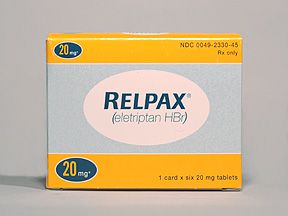Relpax (eletriptan) is a brand-name drug that’s prescribed for migraine with or without aura in adults. Relpax comes as an oral tablet that’s taken as needed to treat migraine episodes when they happen.
Relpax belongs to a drug class called triptans. Relpax is available in a generic version.
Keep reading for specific information about the dosage of Relpax, including its strengths and how to take the medication. For a comprehensive look at Relpax, including its limitations of use, see this article.
Note: This article describes typical dosages for Relpax provided by the drug’s manufacturer. When taking Relpax, always follow the dosage prescribed by your doctor.
Below is information about common Relpax dosages, as well as the form and strengths the drug is available in.
Relpax form
Relpax comes as an oral tablet.
Relpax strengths
Relpax tablets are available in two strengths: 20 milligrams (mg) and 40 mg.
Typical dosages
The following information describes dosages that are commonly used or recommended. However, be sure to take the dosage your doctor prescribes for you. Your doctor will determine the best dosage to fit your needs.
Your doctor may prescribe a Relpax dose of 20 mg or 40 mg for treating a migraine episode with or without aura. If you still have symptoms, you may take a second dose 2 hours after the first dose. However, you should not take more than 80 mg over a 24-hour period.
Maximum dose
The maximum single dose of Relpax is 40 mg. The maximum dose over a 24-hour period is 80 mg.
Long-term use
Relpax is meant to be used as a long-term treatment, but you may not need to take it regularly. You should only take it to treat migraine episodes when they occur. If you and your doctor determine that Relpax is safe and effective for you, you’ll likely take it long term.
It isn’t known how safe or effective Relpax is when it’s taken to treat more than three migraine episodes per month. Talk with your doctor if you’re having more than three migraine episodes per month. They may suggest changing your migraine treatment plan to reduce the number of Relpax doses you take each month.
The Relpax dosage your doctor prescribes will depend on:
- the severity of your migraine symptoms
- other medical conditions you have
Be sure to always take Relpax exactly how your doctor prescribes.
Relpax comes as an oral tablet. You may take a dose with or without food.
You should take one dose of Relpax as soon as you feel a migraine episode starting. If you take a dose and still have migraine symptoms 2 hours later, you can take a second dose. But you should not take more than 80 mg of Relpax over a 24-hour period.
It’s also important to keep track of your migraine symptoms and treatments over time. Consider writing down information, such as:
- the day and time that you have a migraine episode
- what time(s) you take a Relpax dose
- whether your migraine symptoms were relieved after taking a Relpax dose
This information can help you and your doctor determine how well Relpax is working for you.
Relpax isn’t a medication that you take on a regular schedule. You’ll take it as needed to stop migraine episodes that are already occurring. You should only take a dose if you’re having a migraine episode.
Relpax isn’t approved by the Food and Drug Administration (FDA) to help prevent migraine episodes, so you should not take it regularly.
It’s important that you do not take more Relpax than your doctor prescribes. For some medications, taking more than the recommended amount may lead to side effects or overdose.
You should not take more than a total of 80 mg of Relpax over a 24-hour period.
If you take more than the recommended amount of Relpax
Call your doctor right away if you believe you’ve taken too much of Relpax. Another option is to call America’s Poison Centers at 800-222-1222 or use its online tool. If you have severe symptoms, immediately call 911 or your local emergency number, or go to the nearest emergency room.
The dosages in this article are typical dosages provided by the drug manufacturer. If your doctor recommends Relpax for you, they will prescribe the dosage that’s right for you. Always follow the dosage that your doctor prescribes for you.
As with any drug, never change your dosage of Relpax without your doctor’s recommendation. If you have questions about the dosage of Relpax that’s right for you, talk with your doctor.
Besides learning about dosage, you may want other information about Relpax. These additional articles might be helpful to you:
- More about Relpax: For information about other aspects of Relpax, refer to this article.
- Side effects: To learn about side effects of Relpax, see this article. You can also look at the Relpax prescribing information.
- Details on your condition: For more information on migraine, see our headache and migraine hub and this list of headache and migraine articles.
Disclaimer: Medical News Today has made every effort to make certain that all information is factually correct, comprehensive, and up to date. However, this article should not be used as a substitute for the knowledge and expertise of a licensed healthcare professional. You should always consult your doctor or another healthcare professional before taking any medication. The drug information contained herein is subject to change and is not intended to cover all possible uses, directions, precautions, warnings, drug interactions, allergic reactions, or adverse effects. The absence of warnings or other information for a given drug does not indicate that the drug or drug combination is safe, effective, or appropriate for all patients or all specific uses.

